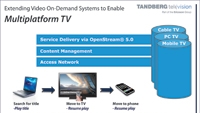Streamlining back-office file management with device-aware software

While virtually every content provider is experimenting with various forms of multiplatform distribution that include traditional TV as well as the Internet and mobile devices, managing all of the extra back-office administration processes associated with a specific video-on-demand (VOD) title is proving to be a nightmare.
For every platform supported, a separate clip must be formatted (encoded) for each title to enable the content to be displayed correctly — resulting in dozens of versions, which requires extra storage, video servers and an automation system that can find the correct file and serve it at the appropriate time.
Other challenges within the existing cable on-demand infrastructure include difficulty in reusing subscriber management and billing systems across platforms, operators can't reuse their current content distribution and asset management systems for more than one platform, and new subscription services are expensive and time-consuming to deploy.
TANDBERG Television thinks it has a better way and demonstrated new software at the recent CableLabs Summer Conference that intuitively knows which device (and which subscriber) is requesting a clip and sends out that clip without any human intervention. The company is calling it the cable industry's first “device-aware” back office for multiplatform TV. It supports content delivery across any platform to any device, while saving time and money for operators.
The new software, still in prototype form, is an add-on module to TANDBERG Television’s OpenStream Digital Services Platform, and the initial goal is to get current OpenStream customers to add the new “device awareness” capabilities (when it becomes available) and leverage their existing on-demand investment in multiplatform TV services.
“We see current OpenStream customers getting much more value out of the platform by adding this new feature,” said Michael Adams, vice president of application software strategy for TANDBERG Television.
The real value of the software is that it leverages the same subscriber ID data now used separately across the various silos or services — TV set-top box, PC and mobile devices — an operator must now maintain separately. Administration of on-demand orders is simplified, thus requiring less people to process. A customer can rent and begin watching a movie on any one of these platforms, stop it at any point, and pick it up from that same point on another device. The subscriber could begin watching a program on the commute home, and then finish it later that evening (or anytime within 24 hours) without missing a beat.
Get the TV Tech Newsletter
The professional video industry's #1 source for news, trends and product and tech information. Sign up below.
“This allows an operator to allow subscribers to rent a VOD title while the user is on the road, thus extracting revenue it would not have captured previously under the traditional model,” said Adams. “That subscriber could also rent a title while away from home, watch it, then allow another member of their family to watch it (within the 24-hour window) at home. The key is to make this service attractive to the end user so they'll want to use it often.”
Using legacy MPEG-2 and newer generation MPEG-4 AVC capable set-top boxes, the software allows the operator to set up special folders for each individual in a particular household. These folders contain content available for viewing on any device. At the headend, the software tells a central VOD server which formatted clip to release, and serves it up for 24 hours. For the subscriber, the interface to the content has the same operator-branded look and feel across all devices used.
“The overall billing system database is aware of the subscriber when they make a purchase, regardless of which device they are currently using,” Adams said, explaining that this ability to watch on any device is called “session shifting.”
The new back-office software application leverages the OpenStream platform and its internal data management tools and universal file support that are already built-in (and have been since the platform’s inception). Going forward, TANDBERG is hoping that third-party developers will write new applications and custom interfaces (with advertising and branding) to run on the OpenStream platform.
To use the OpenStream Platform, operators use standard PC-based servers that stream content on-demand via IP and expandable storage arrays. The system streams the content to the correct device, either via cable, IP or WiFi connectivity — in the case of portable equipment. Another TANDBERG content management product called Watch Point CMS can be used to automatically generate new versions (different formats and resolutions) of a piece of content, and then users can have the OpenStream platform manage and serve the correctly formatted clip, as needed. The system can work with any encoder on the market, not just TANDBERG’s.
The different services require content to be coded in various ways and delivered in different ways, with several diverse formats stored against a particular movie title.
Requesting movies and other content on mobile video applications will be just as seamless to the subscriber as traditional cable VOD ordering is today.
“Whether the content is delivered via a 3G or 4G network, it’s simply a matter of setting up the correct IP path,” said Adams, adding that content distribution networks will play a key role in delivering the various clips. “The real issue we're targeting is the management of the thousands of files an operator has to deal with on a daily basis. We’re enabling operators to do that using a single database.”
TANDBERG Television will also demonstrate the new device-aware capability at the IBC show in Amsterdam in September.
“We’ve developed a new kind of software intelligence that delivers the appropriate content to the appropriate device via the appropriate network with the appropriate protocol,” said Adams. “For operators, we think it will make the launch of new services easier and less costly, while subscribers get the benefit of consuming content when and where they want to.”
